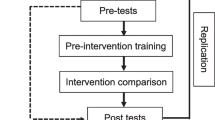Abstract
A learning situation in which the principal content of what is to be learned is not given but is independently discovered by the learner is often considered “discovery learning.” Recently, learning scientists have been able to make explicit some of the conditions under which such independent discovery is likely to occur (Andronis, 1983; Epstein, 1996; Johnson & Layng, 1992). One form of “discovery” can often be observed when skills learned under one set of conditions are recruited under new conditions to serve a new or different function—a process of “contingency adduction” (Andronis, Layng, & Goldiamond, 1997). The research reported here investigated the application of contingency adduction in a discovery learning context to establish sound-to-letter correspondence as part of an online reading/decoding program, Headsprout Early Reading. Beginning readers acquired novel letters/sounds correspondence with minimal presentations and few errors—often requiring only one presentation. This research suggests that instructional sequences may be designed to provide effective discovery learning activities to teach some phonics skills.
Similar content being viewed by others

References
Andronis, P. T. (1983). A novelform of aggression by pigeons: Contingency coadduction. Dissertation, The University of Chicago.
Andronis, P. T., Layng, T. V. J., & Goldiamond, I. (1997). Contingency adduction of “symbolic aggression” by pigeons. The Analysis of Verbal Behavior, 14, 5–17.
Bronowski, J. (1978). The origins of knowledge and imagination. New Haven, CT: Yale University Press.
Clark, D. (1999). Discovery Learning (Updated January 22, 2000) http://www.nwlink.com/~donclark/hrd/history/history.html.
Epstein, R. (1996). Cognition, creativity, and behavior: Select essays. New York: Praeger.
Goldiamond, I. & Thompson, D. (1968, reprinted 2004). The functional analysis of behavior. P. T. Andronis (Ed.), Cambridge, MA: Cambridge Center for Behavioral Studies.
Johnson, K. R., & Layng, T. V. J. (1992). Breaking the structuralist barrier: Literacy and numeracy with fluency. American Psychologist, 47, 1475–1490.
Layng, T. V. J. (1991). A selectionist approach to verbal behavior: Sources of variation. In L. J. Hayes, & P. N. Chase (Eds.), Dialogues on verbal behavior (pp. 146–150). Reno, NV: Context Press.
Layng, T. V. J. (1995). Causation and complexity: Old lessons, new crusades. Journal of Behavior Therapy & Experimental Psychiatry, 26,3, 249–258.
Layng, T. V. J., & Andronis, P. T. (1984). Toward a functional analysis of delusional speech and hallucinatory behavior. The Behavior Analyst, 7, 139–156.
Layng, T. V. J., Twyman, J. S., and Stikeleather, G. (2004). Selected for success: How Headsprout Reading Basics™ teaches beginning reading. In D.J. Moran & R. Malott (Eds.) Evidenced-based educational methods. St. Louis, MO: Elsevier Science/Academic Press.
Neuman, S. B., & McCormick, S. (2002). A case for single subject experiments in literacy research. In M. L. Kamil, P. B. Mosenthal, P. D. Pearson, & R. Barr (Eds.) Methods of literacy research (pp. 105–118). Mahwah, NJ: Lawrence Erlbaum Associates.
Schiller, P. H. (1957). Innate motor-action as a basis of learning: Manipulative patterns in the chimpanzee. In P. H. Schiller (Ed.), Instinctive behavior: The development of a modern concept (pp. 264–287). New York: International Universities Press, Inc.
Sidman, M. (1960). Tactics of scientific research: Evaluating experimental data in psychology. Boston, MA: Authors Cooperative, Inc.
Stikeleather, G. & Sidman, M. (1990). An instance of spurious equivalence relations. The Analysis of Verbal Behavior, 8, 1–12.
Twyman, J. S., Layng, T. V. J., Stikeleather, G., & Hobbins, K. A. (2004). A non-linear approach to curriculum design: The role of behavior analysis in building an effective reading program. In W. L. Heward et al. (Eds.), Focus on behavior analysis in education, Vol. 3. Upper Saddle River, NJ: Merrill/Prentice Hall.
Author information
Authors and Affiliations
Corresponding author
Rights and permissions
About this article
Cite this article
Layng, T.V.J., Twyman, J.S. & Stikeleather, G. Engineering Discovery Learning: The Contingency Adduction of Some Precursors of Textual Responding in a Beginning Reading Program. Analysis Verbal Behav 20, 99–109 (2004). https://doi.org/10.1007/BF03392997
Published:
Issue Date:
DOI: https://doi.org/10.1007/BF03392997



